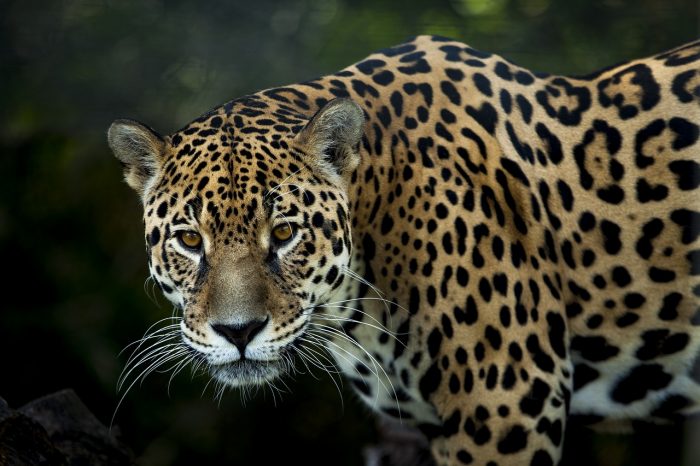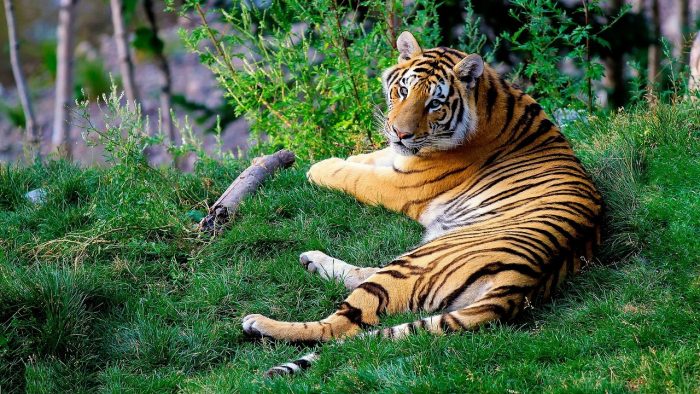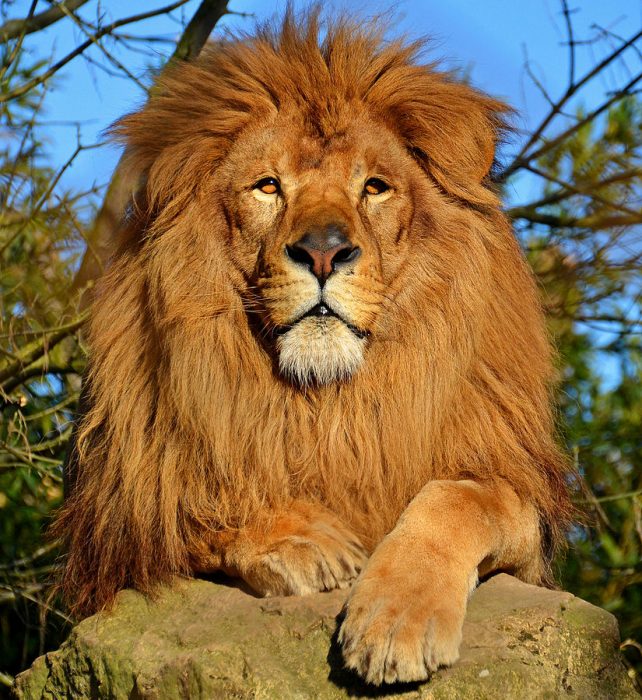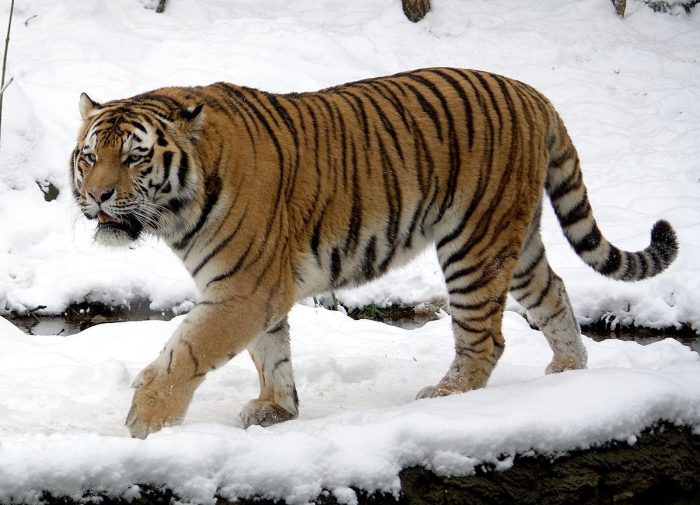
In biology, the term “big cat” normally refers to organisms in the genus Panthera and most often is used to describe the 4 main types of big cats; lions, tigers, jaguars, and leopards. Most big cats are predatory carnivores who are known for being fierce hunters and fighters. The term “big cat” is more than a term of endearment as well; these cats tend to be very large and physically powerful. The term big cat can also refer some cats in the larger classification of the Felidae family, which includes cougars and cheetahs.
Big cats are among the most recognizable and popular animals in the world. Big cats are native to the Americas, Africa, and Asia, though the majority of big cats are only found in Africa and Asia. Unfortunately, many big cat species in the world are currently either endangered or on the verge of extinction due to loss of habitat and human poaching.
The term “big cat” may prompt one to think “how big?” The answer is: HUGE. Big cats routinely weigh around 500 pounds and can measure anywhere between 5-12 feet long. Some species of big cats can reach over 1,000 pounds and eat up to half their body weight in a single day. So, in honor of these glorious megafauna, let’s take a look at some of the biggest big cats in the world.
What Are the Biggest Cats In the World?
Jaguar

Credit: Pixabay
Average Weight: 123-212 pounds
Average Length: 3.5-6 feet.
Jaguars (Panthera onca) are a species of big cat found in parts of the Southwestern US, Mexico, Central America, and Sout America. The jaguar is the only member of the genus Panthera that is native to the Americas. They prefer forest, swamps, and wooded regions as their habitats, though they are found in many open environments.
Jaguar weight can vary considerably, but most fall in the range of 123-212 pounds. Larger male jaguar specimens have been known to reach over 300 pounds. Female jaguars are usually 20% smaller than males. The biggest jaguars measure over 6 feet in length. The most distinctive physical characteristic of jaguars is their orange and black patterned fur. The rosettes on the fur serve as camouflage in their forest habitats.
Jaguars are the apex predator in their environments and are adept hunters, swimmers, and climbers. Their stocky and well-muscled frame gives them a lot of strength; a normal jaguar can reach speeds of up to 55 mph and has a bite force of over 1,000 pounds. Jaguars hunt and eat virtually any terrestrial vertebrate in its environment, except crocodiles. Jaguars are very good swimmers and will dive in the water to catch fish, turtles, and frogs. Jaguars hunting habits are unique among big cats. Instead of attacking their preys’ throats or suffocating them, they bite into the temporal lobe and pierce the brain with their sharp canine teeth.
Jaguars are currently listed as near-threatened by the IUCN Red List and populations are rapidly declining. This decline is driven primarily through deforestation and hunting. Ranchers often kill jaguars because they serve as a threat to their livestock and jaguars are hunted by poachers for their pelts. It is estimated by the WWF that only 15,000 jaguars are left in the wild.
Lion
Average Weight: 330-550 pounds
Average Length: 5.6-8.2 feet
Next up is everyone’s favorite king of the jungle, the lion. Despite the moniker “king of the jungle” (and the ridiculously popular song “The Lion Sleeps Tonight”), lions (Panthera leo) are actually not native to jungles and are almost never found there unless deliberately introduced. Lions are native to the Savannah plains of Africa where they are the ecosystem’s apex predator.
Lions are large, muscular, and usually weigh 330-550 pounds for males and 265-400 pounds for females. Lions have a short muscular neck, deep chest, and broad muscular shoulders. Male lions are distinguished for the characteristic mane that surrounds their head. Mane color and size is dependent on subspecies, age, environmental conditions, and range in color from light gold to a brownish black.
Fitting for a big cat of their stature, Lions are fierce predators who actively hunt and stalk their prey. Lions are the most social of the big cats and exist in large social groups called prides. Lion prides are composed of multiple members and their offspring who live together sharing food and protection. Lions eat mostly grazing mammals that exist in their area, including gazelles, zebras, giraffes, and African buffalo. Lions frequently engage in fights with leopards, cheetahs, and hyenas, but they rarely eat them afterward.
Unfortunately, habitat loss and human poaching have caused lion populations to rapidly dwindle in the 20th and 21st century. It is estimated that there currently exist 20,00-39,000 lions in the wild.
Siberian Tiger
Average Weight: 397-675 pounds
Average Length: 7.8-9.9 feet
Siberian tigers are subspecies of tiger that is native to Northern Asia, specifically Russia and Northeast China. The Siberian tiger has had many names through history, including the Amur tiger, Manchurian tiger, and Korean tiger.
Siberian tigers are large and generally weigh around 397-675 pounds for males and 220-368 pounds for females. They measure anywhere between 7.8-11 feet long. Historically, the Siberian tiger was the largest subspecies of tiger, though population declination and loss of food sources in the past century have caused the average weight of Siberian tigers to drop.
Male Siberian tigers are solitary hunters who spend much of their adult life along on the prowl. Occasionally, they will form a family unit with a female for a short period of time until their offspring are ready to be independent. It is hard to investigate Siberian tiger sociality in the wild because so few of them still exist.
Siberian tigers are the apex predator of their environments and feed on most species of mammal. They use their impressive size and powerful jaws to leap at prey, trap, and suffocate them. Siberian tiger population often shift location to reflect the distribution of prey species.
Siberian tigers are currently on the verge of extinction. Widespread loss of habitat and poaching have cause number to decline so much that in the 1940s, there were an estimated 20 to 30 Siberian tigers left in the wild. Strict laws banning the poaching and trade of Siberian tigers plus extensive conservation efforts have raised the population of wild Siberian tigers to 500 in recent years, though the species is severely endangered.
Bengal Tiger

Credit: Pixabay
Average Weight: 500-717 pounds
Average Length: 8.9-12 feet
The Bengal tiger (Panthera tigris tigris) is a subspecies of tiger that is primarily found on the Indian subcontinent and Southeastern Asia. The Bengal tiger is known for its characteristic orange and black stripe pattern. Bengal tigers are the largest tigers in the world and have an average weight of around 550 pounds and measure almost 11 feet long. Some Bengal tigers reach over 700 pounds at some point in their lives. The largest Bengal tiger on record weighed almost 900 pounds and measured more than 13 feet long.
Unlike lions, Bengal tigers are mostly solitary and do not form large social groups. The only common groups of Bengal tigers are females and their offspring. Bengal tigers are obligate carnivores and feed on most kinds of mammals in their habitat—particularly ungulates (hooved mammals). There have been reports of Bengal tigers attacking and killing large elephants, rhinoceroses, and venomous snakes. Bengal tigers have also been known to attack humans and are one of the regions most dangerous man-eater species. They leverage their large size and powerful physique to subdue prey and rip their throats open before feasting on their carcasses.
Unfortunately, the world’s population of Bengal tigers has dramatically declined in the 20th and 21st century. Habitat loss and human poaching are the two main causes of this decline. There are currently around 2,500 Bengal tigers left in the world, both in the wild and in captivity.
Liger

Credit: Public Domain
Average Weight: 750-900 pounds
Average Length: 10-12 feet
A liger is a hybrid organism made by the mating of a male lion and a female tiger. The first recorded mentions of ligers come from India around the turn of the 19th century. Male ligers are sterile and cannot produce their own offspring, but female ligers can produce offspring with other species of cat.
Ligers are the largest known breed of cat and routinely reach weights of greater than 800 pounds and lengths over 10 feet. The largest ever liger was a male liger named Nook who weighed 1,213 pounds. Physically, ligers resemble a mixture of the parent species, a lion-esque fur with faint tiger-like stripes. Ligers also share behavioral traits of both parent species. Ligers enjoy swimming, like tigers, and are social cats, like lions. Unlike the parent species, ligers are generally not aggressive or territorial. They tend to remain peaceful and docile into maturity.
Ligers are deliberately bred and only exist in captivity because the parent species environments do not overlap in nature. It is estimated that only about 100 ligers exist in the world. There are reports and stories about Bengal tigers and Asiatic lions mating in the wild and reports of wild tiger populations, but none of these claims have ever been confirmed.










